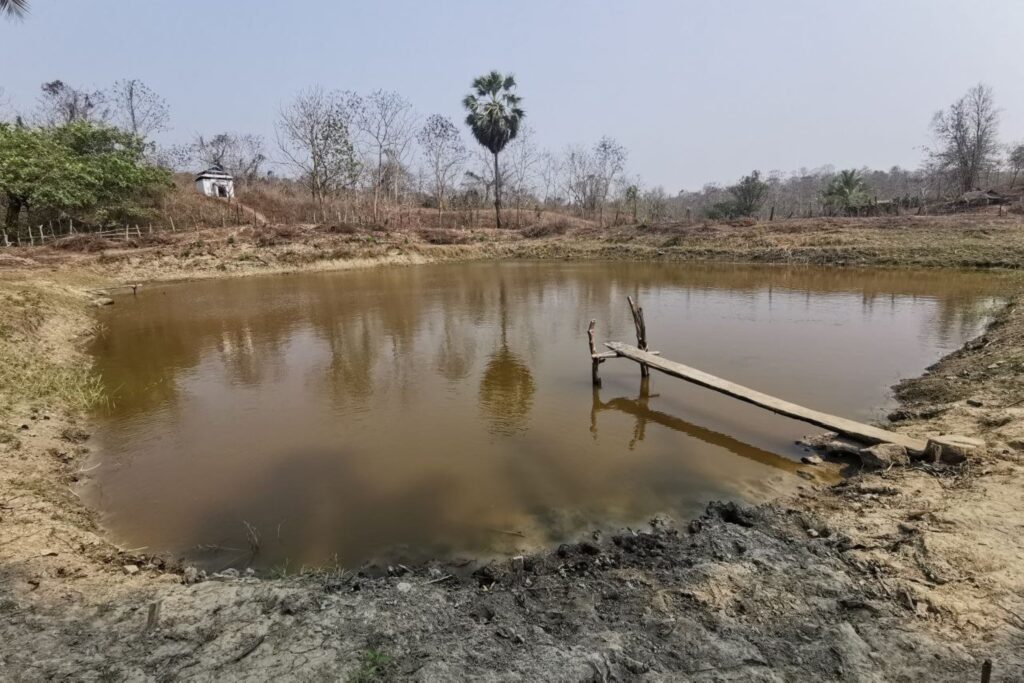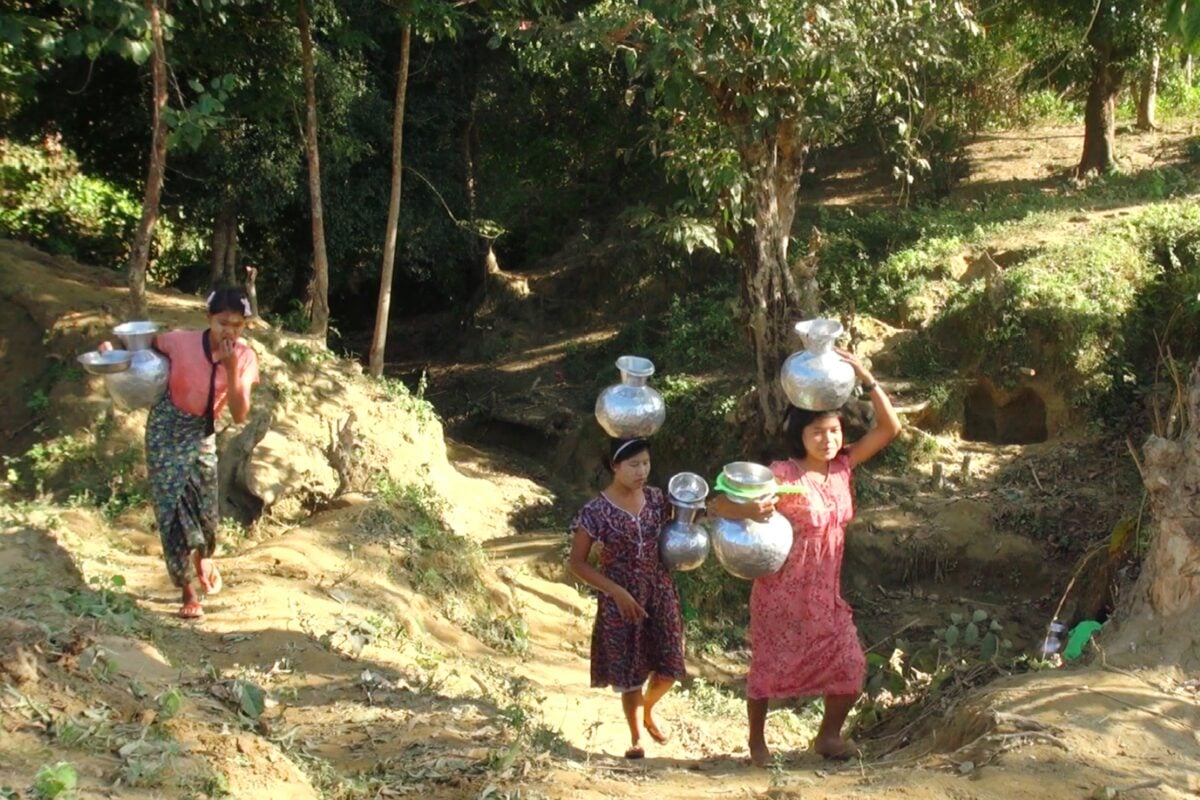RAKHINE, MYANMAR – One year after Cyclone Mocha hit Rakhine state, residents still have limited access to drinking water as the storm damaged most of their water sources. The water shortage has also been exacerbated by ongoing clashes between the military and armed ethnic groups.
Ngu Wah Che, a resident in Pan Myaung village in northern Min Pya Township, has to wake as early as 3am to fetch drinking water from a pond near her village.
Like other women responsible for household water collection, her early arrival at the pond is necessary to avoid long lines due to the scarcity of water sources.

“I find myself spending more time on this task. Even after reaching the pond, the water is not always readily available,” said Ngu Wah Che. “I often have to wait [until the water from the ground rises to the surface.] Despite spending one to two hours waiting, the water level in the pond has not even reached 1.5 feet.”
Since Cyclone Mocha hit coastal Rakhine state on May 14 last year, hundreds of wells and ponds have been inundated and contaminated by saltwater. Some have been buried under fallen trees and debris, spoiling the water quality.
The cyclone also destroyed more than 200,000 houses and buildings, displacing 1.6 million people across the country.


A report titled The Aftermath of the Powerful Cyclone Mocha, compiled by local media outlet DMG News, found that all water sources in nine villages spanning Mrauk-U, Pauktaw and Rathedaung townships in northern Rakhine state had been affected.
The study also surveyed five other villages in the area, where 80% of the water sources were damaged, demonstrating the significant impact of Cyclone Mocha on people’s access to fresh water.
These townships are also hotspots for ongoing clashes between the State Administration Council (SAC) forces and the Arakan Army, increasing the risk for villagers on the trek to fetch water.
Unhygienic water
Rakhine State is a coastal region which is home to 3.4 million people, with more than 80% of them living in arid rural areas. This region has also been the site of the ongoing persecution of the Muslim ethnic Rohingya, resulting in a migration crisis.
Even before Cyclone Mocha, water scarcity was a challenge for the people of Rakhine, particularly during the dry season from November to May. In the cyclone’s aftermath, combined with a recent heatwave, the situation has worsened.
Su Su Lwin, who lives in Tae Chaung village in Kyaukpyu Township, said villagers have been forced to develop their own strategies to secure drinking water.
“They have to dig the ground in nearby forests and mountains to access water, albeit one pot per person at a time. The water they get is not clean. Clean water is scarce in our vicinity,” she explained.

The lack of access to clean water is a significant concern for villagers, especially women responsible for household hygiene and sanitation.
“If children consume unhygienic water and fall sick, it’s not convenient for us to travel to Kyaukpyu [the nearest town] to seek medical help. This can lead to premature deaths,” said another resident, Daw Win Myint.
Some residents reported that the unclean water had caused skin problems such as large boils and sores on their faces. It has also become very inconvenient for women to maintain hygiene during menstruation.
Fighting disrupts water access
The water scarcity has worsened due to escalating fighting between the SAC and the Arakan Army, as both sides vie for control over towns in Rakhine State.
The military has imposed restrictions on the flow of goods in the region, and roads are often blocked by deadly clashes.
Communication has also been disrupted, with the military cutting internet and phone lines, making it difficult to assess the scarce amounts of water or provide aid to villagers.
This situation has also led to the suspension of many aid activities provided by both local and international humanitarian organizations and posed a challenge for aid groups trying to reach villagers.
“In normal circumstances, we discussed with the township council the solution to pump water from the Lemyo River. It’s not feasible for us to proceed with this option amidst the fighting,” said an anonymous official from the All Arakan Youth Organizations Network.
The 261-kilometer Lemyo River flows through three northern townships in Rakhine State – Mrauk-U, Min Pya and Pauktaw. Two dam projects were planned on the river to improve people’s access to water and electricity, but they have been suspended due to the conflict.
In previous years, some local businesses transported water from the river to villagers for daily consumption, increasing convenience for households and women to access water.
However, Myanmar’s inflation and economic crisis resulting from the civil war have raised gasoline prices, increased the costs of water distribution and forced many businesses to shut down.
With their sole reliance on natural and man-made ponds and wells, Ngu Wah Che from Pan Myaung village said it had been challenging to ensure an adequate water supply for the 4,000 households in her village. Only eight wells are available.
Despite the civil war, various local civil society organizations and aid groups have made efforts to secure donations for water pumps and drinking water supplies.

Rising temperatures
Initiated by the Rakhine State Irrigation and Water Utilization Management Department, 11 sluice gates were constructed in canals between 2018 and 2019 to address the water shortage. Despite these efforts, water scarcity remains a common issue every year.
Authorities in the region have been distributing drinking water using fire engines in both urban and some rural areas. However, local residents have said the amount provided barely meets their daily drinking water needs and only serves as short-term assistance.
This reporter contacted SAC officials based in Rakhine State to inquire about their efforts to address the current water problems, but there was no response.
Ko Tun Kyi, a Rakhine political activist, emphasized the need for long-term solutions to prevent water scarcity in the region.
“We must deliver long-term plans and take action accordingly,” he said, adding that authorities should construct more sluice gates to store rainwater in canals and implement a comprehensive water supply and distribution plan.
“Under the junta regime, deforestation has been rampant and led to the disappearance of water springs. This has intensified water problems.”
He also addressed the impact of climate change on Rakhine State, where people have been experiencing rising temperatures and more frequent natural disasters like landslides and powerful storms.

The average temperature in Rakhine has risen by 0.57 degrees Celsius per decade, according to a 2017 report released by the World Wide Fund for Nature.
As temperatures continue to rise, the region and the whole country will likely face more severe water shortages.
Myanmar recorded its hottest-ever April temperature of 48.2 degrees Celsius in Chauk town in central Myanmar this year, while Rakhine’s temperature hit its highest at 40 degrees Celsius last year.
Su Su Lwin, a resident of Tay Chaung village, hopes for improved access to drinking water, particularly as more women are now forced to do extra work because of the worsening water scarcity.
“Women typically spend their time at home cooking and fetching water, which can disadvantage them and limit their opportunities,” she said.
This story was produced with support from the Internews’ Earth Journalism Network and the Australian Water Partnership. It was first published in Burmese on VOA.





